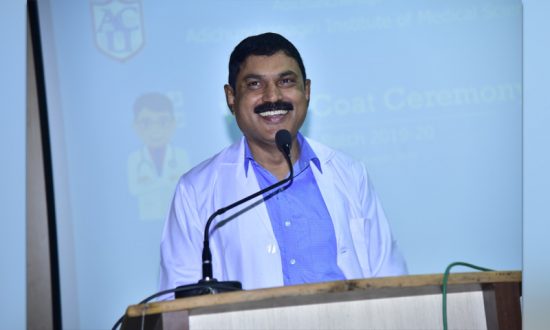Dr. Shivramu is the Principal and Professor of Forensic Medicine at the Adichunchanagiri Institute of Medical Sciences. With 25+ years of academic experience, Dr. Shivramu has had various papers and books published, which has won multiple awards and accolades. Starting his academic career as a Lecturer in 1994, he joined the AIMS family in 2005 as the department head. Since 2010 he is serving as the Principal of the institution, and in 2018 he took the responsibility of the Dean, Health Sciences (Medical) of Adichunchanagiri University and has been contributing to educational development ever since.
The use of technology in health care delivery has evolved rapidly in terms of expectations in patient care, adopting newer and advanced technology in diagnosis and treatment of clinical conditions and is also playing a vital role in patient education. This has also brought in several changes in medical education. Medical educators across the globe are challenged to use these innovations in technology in training the “next generation” physicians.
The use of technology in medical education has gained enormous significance over the last decade. Advances in communication and information technology have been very rapid. They have diffused into our day-to-day life in the form of the internet, personal computers, and smart handheld devices. Adapting to this new norm has definite implications in education.
Since its beginning, the COVID-19 pandemic has been reported to affect more than 1.6 billion learners in more than 200 countries and has deprived them of face-to-face teaching. Ever since the beginning of the COVID-19 pandemic, medical education and training have been significantly disrupted. The absence of face-to-face teaching and lack of interaction with patients has greatly affected clinical training. Addressing the skill training of the young doctors using online teaching has been an enormous challenge. The pandemic has further enhanced the need for adopting technology in medical education to deliver the curriculum in the absence of face-to-face teaching effectively. Online teaching and e-learning have become an integral part of the medical curriculum these days.
Challenges to adapting to technology in medical education
Even though cognitive, attitude, and ethical components have been addressed to a great extent using online platforms, the challenge remains in training in psychomotor skills. Practical and clinical component forms a significant part of the medical education curriculum and technology can play a considerable role in compensating for the absence of face to face teaching.
The major challenge in adapting technology in medical education remains in recreating compelling, real-life clinical encounters, the doctor-patient interaction, learning essential clinical skills remotely. Apart from the clinical learning happening in the hospital, skill and simulation labs played a crucial role in training undergraduates and postgraduates. But, the absence of students on campus has resulted in a significant lacuna in professional training.
Another significant challenge is to provide all students uninterrupted access to learning resources. This may not be easy considering that most students still may not have access to good internet facilities and smart devices. Educators worldwide need to find ways of reaching out to every student so that no one is deprived of their right to access quality medical education.
The pandemic has provided a great opportunity to medical educators to experiment, innovate in transforming the principles of medical education, pedagogical techniques, and assessments to address the void created by the pandemic. The real challenge is to adapt to this new norm by encouraging the use of artificial intelligence, virtual reality and learning engineering in the field of medical education.
Medical educators across the globe have responded well in adapting to the newer need and challenges in implementing the medical curriculum during this difficult period of the pandemic. The response has included a rapid shift to the use of both synchronous and asynchronous modes of online teaching-learning methods, adopting effective learner involvement strategies, and also use of innovative assessment techniques to assist learning and also assess learning
Various web-based platforms, learning management systems, social media have been used vigorously by educators to provide the best learning experiences to medical students across the globe. Telemedicine, artificial intelligence, and chatbots are being increasingly used to achieve an easy connection between educators and students and doctors and patients.
There has been an increasing trend in the use of open educational resources (OER). This OER are available free of cost to both educators and the students. Swayam Prabha, the free DTH channel for education, by the ministry of MHRD, Government of India, is one such example of an OER which is providing lakhs of medical students free and complete access to resources related to the medical curriculum. A wonderful initiative created by collaborative efforts of the eminent faculties across the country is trying to fill in the doid created by the pandemic
Remote medical education needs to quickly adapt to the six steps of Kern’s curriculum design. This calls for a collaborative effort from all medical educators across the world. All educators must assess the learner’s need in the online learning environment, define achievable learning objectives, focus on identifying ideal instructional techniques to engage the learner, assess the learner, provide feedback, and feedforward. As quoted by Said HT and Schwartz AW, the focus of the medical educators should be on the pedagogy but not the platform!
Remote medical education is here to stay, even long after this pandemic is over. This transformative change will have significant benefits but will also throw several challenges at us. Ultimately, we need to look forward and adapt strategies that best suit the needs of our students and avoid scarring that the pandemic is threatening to leave behind!




